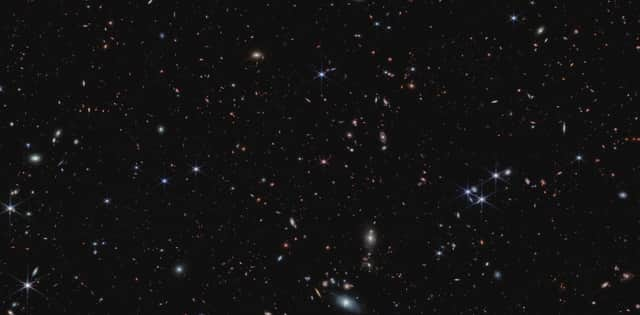James Webb: astronomers snap image of quasar as the telescope proves galaxies transformed the early universe
and live on Freeview channel 276
The James Webb Space Telescope once again displays its power after scientists captured an image teeming with 20,000 galaxies. But the most startling thing is in the middle. Centred in the picture is one of the brightest objects in space - a quasar.
This is a supermassive black hole at the centre of a galaxy which eats heaps of cosmic matter as it releases outbursts of energy -making it millions to billions brighter than the sun. So what is the significance of this picture and what can it tell us about the universe? Here is everything you need to know.


What is the significance of this picture?
Advertisement
Hide AdAdvertisement
Hide AdDuring the Era of Reionization, the universe underwent dramatic changes that saw a massive change from gas in the universe being incredibly hot and dense, to it cooling over a period of hundreds of millions of years.
Then the gas became hot again and ionized, which NASA says is likely due to the formation of early stars in galaxies, and over the next millions of years, the gas became transparent. However, researchers have long sought evidence to explain these transformations.
The picture, which was captured by a research team led by Simon Lilly of ETH Zurich in Switzerland, may show new information about the end of this reionization period. Daichi Kashino of Nagoya University in Japan, the lead author of the team’s first paper said: "Not only does Webb clearly show that these transparent regions are found around galaxies, we’ve also measured how large they are. With Webb’s data, we are seeing galaxies reionize the gas around them.”
The regions of transparent gas are gigantic compared to the galaxies situated inside them. The Webb data shows that relatively tiny galaxies drove reionization, and cleared massive regions of space around them. Then these bubbles began to grow larger and larger until they merged and caused the entire universe to be transparent.
Advertisement
Hide AdAdvertisement
Hide AdThe team aimed the Webb in the direction of a quasar, and as the quasar’s light travelled toward us through different patches of gas, it was either absorbed by gas that was opaque or moved freely through transparent gas.
The researchers then used the Webb to identify galaxies near this line of sight that showed the galaxies are generally surrounded by transparent regions about 2 million light-years in radius. Until now, researchers didn’t have this definitive evidence of what caused reionization – before Webb, they weren’t certain precisely what was responsible.
The galaxies are "more chaotic than those in the nearby universe,” explained Jorryt Matthee, also of ETH Zürich and the lead author of the team’s second paper. “Webb shows they were actively forming stars and must have been shooting off many supernovae. They had quite an adventurous youth!”
However, the quasar found is the most massively currently known in the early universe and weighs about 10 billion times the mass of the sun. These results were announced by members of the Emission-line galaxies and Intergalactic Gas in the Epoch of Reionization (EIGER) team.
What is shown in the picture?
Advertisement
Hide AdAdvertisement
Hide AdIn the picture, it features the quasar, dubbed 'Quasar SDSS J0100+2802', directly at the centre of the image. It seems pink and has six "diffraction spikes," caused by how the object's radiant light hits the Webb telescope's six-sided mirror.
The extremely distant quasar is ancient, at around 13 billion years old. "Light from these distant quasars began its journey to Webb when the universe was very young and took billions of years to arrive," NASA explained. "We will see things as they were long ago, not as they are today" and in the foreground are bluish stars, also with diffraction spikes.
NASA said this picture gives us a glimpse into how the universe looked about 900 million years after the big bang, just before it became fully transparent. For context, the universe is estimated to be around 13.7 billion years old.
Comment Guidelines
National World encourages reader discussion on our stories. User feedback, insights and back-and-forth exchanges add a rich layer of context to reporting. Please review our Community Guidelines before commenting.
